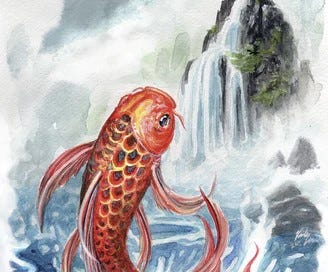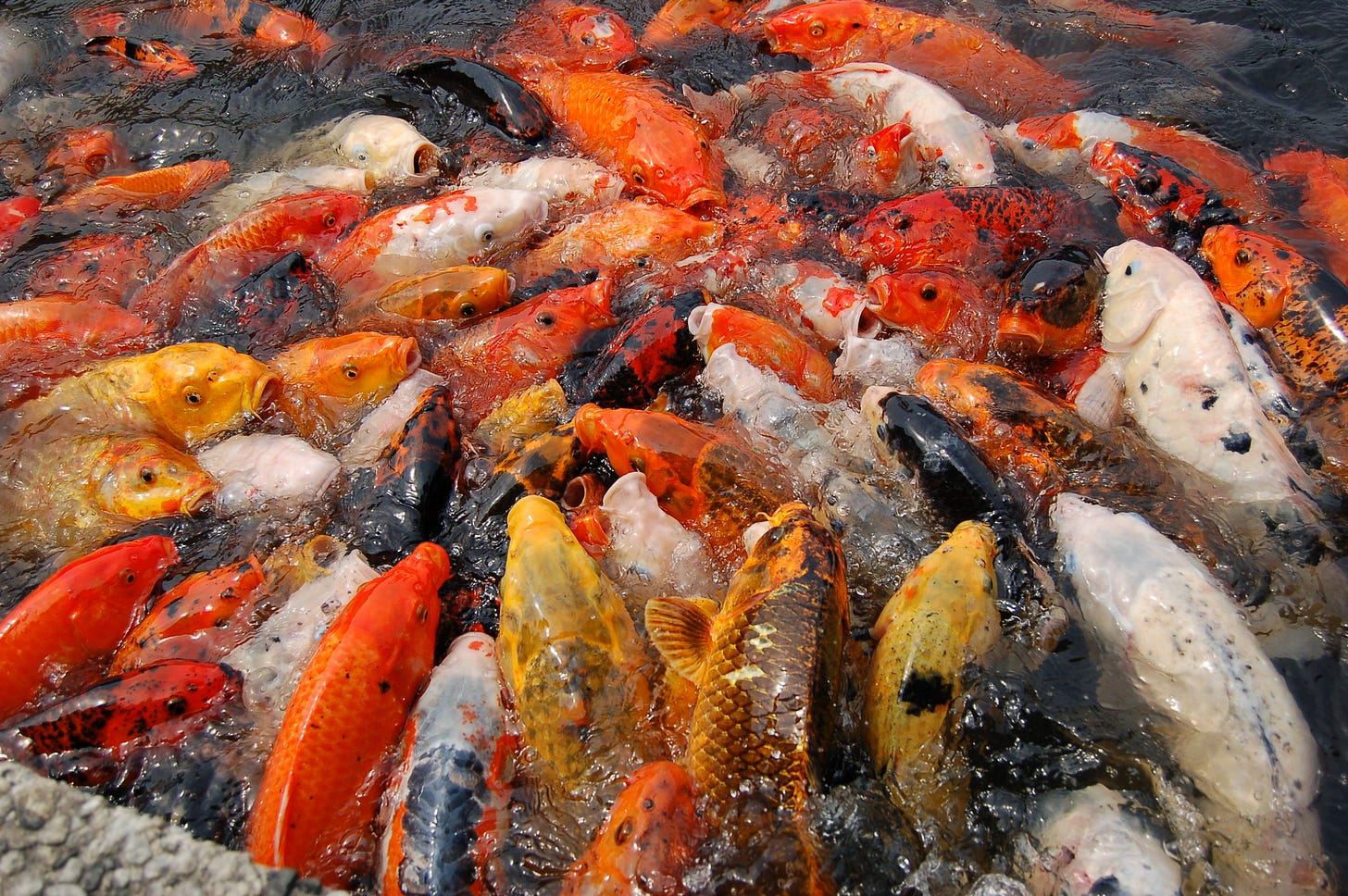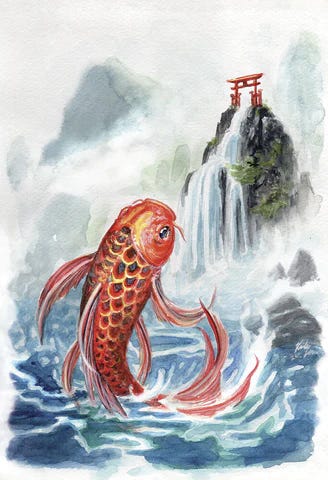This is an article I wrote after numerous requests on Facebook and Instagram.
The image of a colored carp with vibrant Japanese-style motifs is increasingly common today, particularly as it has become a popular choice for tattoos. Yet, for those unfamiliar, there's more to this captivating art—a fascinating myth, and it happens to be one of my favorites.
Koi fish are considered legendary creatures in Japanese folklore—graceful, vibrant, and globally recognized. Despite their association with Japan, Koi originated in Central Asia, introduced to Japan from China. The name "Koi" emerged around 500 B.C., but these fish have a history dating back 20 million years based on ancient fossils. The stunning colors we see today result from natural genetic mutations. In the early 1800s, Japanese farmers started keeping Koi for their aesthetic appeal. Since then, their popularity and myth began to spread rapidly. Additionally, Koi fish gained global attention when a gifted Koi was presented to the Japanese emperor in 1914, enhancing the beauty of the imperial palace's moat.
Another curiosity I want to point out before proceeding is that even though they are thought to live between 25–30 years, the oldest Koi fish ever recorded was named Hanako, born in 1791 and lived an astonishing 226 years, passing away in 1977.
The Koi Fish Waterfall Myth
This myth has deep roots in Chinese folklore, fist, and it was adapted to Japanese culture later. The tale often varies, but one of the popular versions is the legend of the Dragon Gate:
Legend says that long ago, there was an abundance of golden Koi fish in the Yellow River in China. They made their way upstream, going against the current, building strength and perseverance. Their golden hue made the river shimmer as if it was a river of gold.
Halfway upstream, they came to a large waterfall, an impossible height that is too high to traverse. This waterfall is known as the “Dragon’s Gate” in Hunan province. Most of the Koi turned back, going with the current to safer ground. However, some Koi stayed and attempted to jump and surpass the waterfall. Some of them got halfway, but then pummeled back downstream after they’ve lost momentum and energy.
The spirits of the river watched the Koi try over and over again, making fun of them as they found it amusing.
This went on for one hundred years, the group of Koi continued to try and swim up the waterfall, but always stopped at exactly that waterfall. At each attempt, the Koi made it slightly further, gaining technique and strength as they practiced that waterfall.
The spirits continued to make fun of the Koi and heightened the waterfall out of spite, knowing that it’s such an impossible feat to make it past the waterfall.
One Koi tried a different strategy. It went down to the bottom of the river, built up as much speed as it could, and leaped out of the water. It swam as hard as it could up the walls. Somehow, it reached the top of the waterfall, and continued to swim upstream.
The spirits were silenced watching that scene - how the Koi succeeded in the impossible. Knowing the multiple attempts that the Koi have tried over the years,
The spirits transformed the Koi into a golden dragon as a reward for its achievement. In the Chinese culture, a golden dragon is the ultimate symbol of power and strength. That is also how the waterfall is known to be Dragon’s Gate - through this popular fable.
Symbolic of this Myth in our everyday experiences
Koi fish carry positive symbolism, representing strength and perseverance due to the dragon legend and their determined struggle against the current. The lone Koi that conquered the waterfall also symbolizes a fulfilled destiny. This bravery in swimming upstream has connected the Koi with Samurai Warriors in Japanese culture.
Continuous Improvement and Kaizen Philosophy:
The whole idea of getting better and better gradually all the time, inspired by the Japanese concept called Kaizen, is like totally in sync with the Koi fish legend. Kaizen is all about taking it slow and steady, making those tiny tweaks and improvements over time, just like our friend Koi, who's all about that never-ending swim upstream, facing challenges with a warrior’s spirit.
So, when the Koi is caught in that downstream hustle, it's like an open invitation for an upgrade. Instead of getting all gloomy about it, our fish warrior turns those moments into learning experiences, adapting and pushing forward. It's like, "Oops, took a wrong turn, but hey, I'm wiser now!" Embracing the idea of constant improvement is basically saying, "Not a failure, just another chapter in the book of wisdom because losing is just a state of mind."
The Koi conquering that waterfall climb, it's the ultimate symbol of never-ending improvement. People who live by the Kaizen idea know that growing personally and professionally is a journey, not a destination. It's all about constantly boosting our skills, soaking up knowledge, and finding that inner strength. By integrating the Koi's never-give-up attitude, weaving it into our spirit, we can swim the currents of life nobly and driven by the power of our purpose.
Jungian Concepts: The Archetype of Transformation
One captivating concept within Jungian psychology is the archetype of transformation, and the myth of the Koi fish reminds me of it. For those unfamiliar with the concept, Carl Gustav Jung, a Swiss psychiatrist, introduced archetypes as universal symbols and themes deeply ingrained in the collective unconscious of humanity. The archetype of transformation is a fundamental concept associated with the process of individuation, and it involves a symbolic journey, just like in the legend of the Koi.
Individuation is the lifelong process of integrating one's conscious and unconscious elements, leading to the development of a unique and authentic individual identity. It involves recognizing and integrating the various aspects of the self, including both strengths and weaknesses.
The current and the way Koi uses it to gain momentum symbolizes another concept that is part of Individuation, that is, the Integration of Opposites. Individuation and transformation require acknowledging and reconciling opposites within oneself. This involves accepting and integrating both the light and dark aspects of the personality, such as the conscious and unconscious, masculine and feminine, or rational and irrational elements.
Final Words
One last thing I want to point out is that transformation is not a one-time event but a continuous process of renewal and regeneration. It involves shedding outdated or limiting aspects of the self and embracing new possibilities for personal growth and development.
We will encounter many cycles (waterfalls) in our lives to journey. After each of these cycles is done, we will come out changed by the currents of life. Let us, like the Koi, possess the will to persist in our upward journey. May we also develop the wisdom to navigate the challenges (symbolized by the waterfall) in our favor, turning failures into valuable lessons, ensuring our perseverance does not go in vain.
🙏 Appreciate you for reading
If you enjoy my Pen and Sword Journal writing, you can show your support in various ways without any cost by subscribing, liking this post, leaving a comment if you have thoughts to share, or simply sharing it with anyone who might find it interesting.
By subscribing for free, you will receive every week an article the covers topics about warrior psychology and philosophy like this one.
Alternatively, if you wish to contribute more significantly and help sustain the continuous research and daily content creation, you can become a paid supporter of Pen and Sword Journal at just $5 per month.
What you get by becoming a paid supporter is access to extra members-only essays, such as “Mushin 無心: The Samurai Alternative”, or “STRIKE FIRST: Exploring the Strategic Application of a Seizing-The-Moment Mindset”, access to all the archive, as well as an opportunity to recommend topics for future essays.
Your generous contribution means a lot to me, because diving deeper into warrior psychology and human potential is my passion and one of my life purposes, and your support enables me to devote more time to researching and writing high-quality content regularly.
🔻📕Additional Resources:
If you've found the philosophy of the warrior spirit inspiring and want to delve deeper into this subject, I recommend checking out my book, "100 Thoughts for the Inner Warrior."
Whether you're seeking personal growth, to fortify your inner strength and mental resilience, or simply a deeper understanding of the warrior ethos, "100 Thoughts for the Inner Warrior" is a valuable resource that can guide you on your journey. You can find more information about the book and how to get your Paperback or Kindle copy here, and if you like the Hardcover version, you can get it here.
👉 Furthermore, you can consider joining my WhatsApp channel via this link if you don’t want to miss future updates.
See you next week! 🙏






